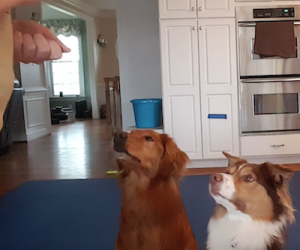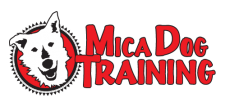There are a lot of details and techniques for treat delivery and reward placement. I want to specifically address keeping your fingers. Having a sharky dog that chomps down on your finger when he takes a treat can use up a lot of Band-Aids and make training a bloody and not very fun sport.

So, if you have a dog that is making you yelp in pain when you give her a treat, ask yourself the following questions:
1) Is your dog stressed or excited? Take a look at your environment. Gambit has a soft mouth 99.5% of the time. But every once in a while, I feel teeth. I felt them today when he saw my neighbor’s donkey and I offered him a treat. Donkeys are exciting and Gambit’s mouth was harder when he took the treat due to his excitement.
2) Is there another dog around? Some dogs will take treats very roughly when there is another dog next to them also wanting a treat.
3) Are your treats too good? Steak or hot dog may not be the best reward for all dogs in all situations.
4) How are you getting the treat to your dog’s mouth? Does your dog have to reach up for the treat or are you bringing the treat directly to his mouth?
Stressed or Excited
If you think your dog’s hard mouth is due to stress or excitement, dropping the treat on the ground or dropping a few treats in the grass can help lower your dog’s arousal level and save your fingers. You can then assess the environment and see if it makes sense to move further away from something that may be stressing or exciting your dog. You may need to take a break and train in a different environment that is less exciting or stressful for a while.
Other Dogs
If you notice your dog is particularly careless with your fingers in a group training class then you will want to consider the environment (see above). If you have other dogs or are with friends’ dogs and notice your dog is particularly sharky when taking treats, you can try saying each dog’s name before giving them their treat. Saying the dog’s name first and then delivering the treat helps each dog know what to expect and they will know when the treat is intended for them. This can eliminate some anxiety on the dog’s part. It also has the added bonus of creating a strong name response.
*If you think any of the dogs are serious resource guarders or likely to fight, please put the treats away and consult with a trainer.
High Value Treats
We often hear that we should use high value treats when training, however, with some dogs this doesn’t work out very well for our fingers. If your dog is chomping on you when you use hotdogs or something high value, try switching to kibble, cheerios, carrots, something your dog is a bit less enthusiastic about but will still work for. Some dogs are able to focus better when the treat is something they like but are not completely crazy over.
Treat Delivery
How you move the treat to your dog’s mouth can also be an important piece of the puzzle when trying to get your dog to stop giving you bloody knuckles. You can always have your dog lick food out of a food tube or take a treat off of your flat open palm to avoid feeling his teeth. You can also toss treats on the ground, but keep in mind that tossing a treat is different from dropping a treat. Tossing a treat can cause a dog to move quickly away from you and the movement can cause excitement, which can make a hard mouth harder.
To keep your fingers, you can also focus on how you deliver the treat to your dog’s mouth, how you hold your hand, where you put the treat, how you let your dog have the treat. This may sound very persnickety but focusing on how the treat moves from your hand to your dog’s mouth can improve your training and save you money in Band-Aids.
I hold the treat between my index finger and middle finger right at the point where my palm and fingers meet. I then cover the treat with my thumb and cup my hand a bit. When I deliver the treat my hand goes in a scoop toward the dog’s mouth and when I want the dog to have the treat, I move my thumb out of the way. It is very hard for a dog to put my entire hand in their mouth. It is much quicker and more effective for a dog to use his tongue to get the treat. I have had good success with this with a wide variety of dogs. However, keep in mind, that any dog that is stressed will have a harder bite.
Here is a video of how I hold a treat and how I let my dog have the treat.
*This technique is my version of trainer Michael Ellis’ food delivery. I am a positive reinforcement trainer and there are lots of things I disagree with Michael Ellis on but he also has a lot of good techniques and I think this is one of them.
Happy Training!
